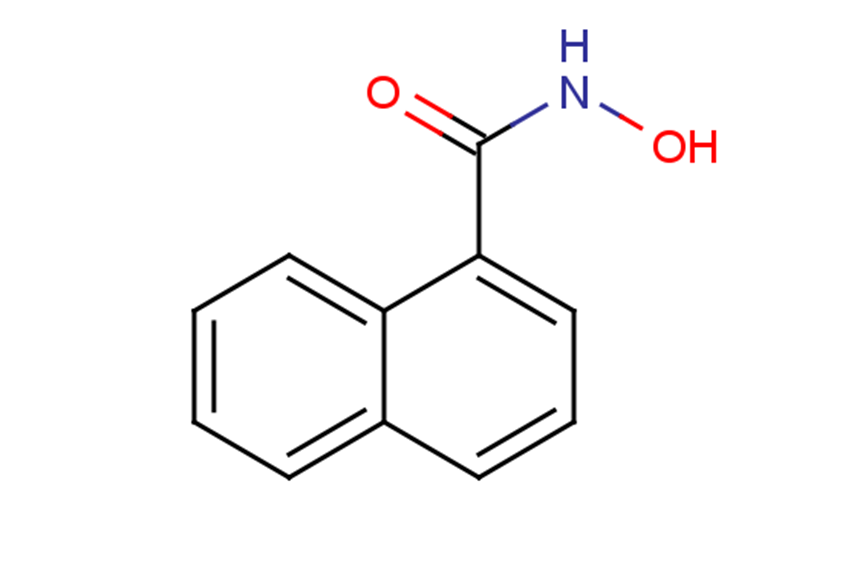
1-Naphthohydroxamic acid
CAS No. 6953-61-3
1-Naphthohydroxamic acid( —— )
Catalog No. M22068 CAS No. 6953-61-3
1-Naphthohydroxamic acid (Compound 2) is a potent and selective HDAC8 inhibitor with an IC50 of 14 μM, and it is more selectively for HDAC8 than class I HDAC1 and class II HDAC6 (IC50 >100 μM).
Purity : >98% (HPLC)
 COA
COA
 Datasheet
Datasheet
 HNMR
HNMR
 HPLC
HPLC
 MSDS
MSDS
 Handing Instructions
Handing Instructions
| Size | Price / USD | Stock | Quantity |
| 5MG | 46 | In Stock |


|
| 10MG | 87 | In Stock |


|
| 25MG | 174 | In Stock |


|
| 50MG | 335 | In Stock |


|
| 100MG | 500 | In Stock |


|
| 500MG | 1098 | In Stock |


|
| 1G | Get Quote | In Stock |


|
Biological Information
-
Product Name1-Naphthohydroxamic acid
-
NoteResearch use only, not for human use.
-
Brief Description1-Naphthohydroxamic acid (Compound 2) is a potent and selective HDAC8 inhibitor with an IC50 of 14 μM, and it is more selectively for HDAC8 than class I HDAC1 and class II HDAC6 (IC50 >100 μM).
-
Description1-Naphthohydroxamic acid (Compound 2) is a potent and selective HDAC8 inhibitor with an IC50 of 14 μM, and it is more selectively for HDAC8 than class I HDAC1 and class II HDAC6 (IC50 >100 μM). 1-Naphthohydroxamic acid does not increase global histone H4 acetylation and also does not reduce total intracellular HDAC activity, But it can induce tubulin acetylation. 1-Naphthohydroxamic acid (compound 2; 20-40 μM; 0-144 ?hours; BE(2)-C, SK-N-BE(2) and SH-SY5Y cells) treatment reduces cell numbers in a concentration-dependent manner. 1-Naphthohydroxamic acid reduces the formation of clones in soft-agar concentration dependently.. When either cell type (HeLa and HEK293 cells) is treated with 1-Naphthohydroxamic acid (compound 2; 0.8 μM, 4 μM, 20 μM or 100 μM), only tubulin becomes hyperacetylated[1]. 1-Naphthohydroxamic acid (compound 2) at concentrations in the range of its in vitro IC50 against HDAC8 results in reduced cell density and outgrowth of neurite-like structures that stained positive for neurofilament.1-Naphthohydroxamic acid has the maximum tolerable doses at 50?mg/kg per day. At these concentrations, neither body weight nor blood parameters are critically changed[3]. Dose-limiting toxicities (DLTs) of 1-Naphthohydroxamic acid (compound 2; 0-40 mg/kg; intraperitoneal injection; daily; for 10 day; NMRI Foxn1 nude mice) include weight loss and signs of liver toxicity, as evidenced by elevated plasma liver enzymes and detection of necrotic areas on histological liver examination. Pharmacokinetic studies after intraperitoneal administration of the inhibitors identified the half-life of 1-Naphthohydroxamic acid to be ~15?min, with a plasma peak concentration of ~30?μM.
-
In Vitro1-Naphthohydroxamic acid (compound 2; 20-40 μM; 0-144 ?hours; BE(2)-C, SK-N-BE(2) and SH-SY5Y cells) treatment reduces cell numbers in a concentration-dependent manner.1-Naphthohydroxamic acid (compound 2) at concentrations in the range of its in vitro IC50 against HDAC8 results in reduced cell density and outgrowth of neurite-like structures that stained positive for neurofilament.1-Naphthohydroxamic acid reduces the formation of clones in soft-agar concentration dependently.When either cell type (HeLa and HEK293 cells) is treated with 1-Naphthohydroxamic acid (compound 2; 0.8 μM, 4 μM, 20 μM or 100 μM), only tubulin becomes hyperacetylated. Cell Proliferation Assay Cell Line:BE(2)-C, SK-N-BE(2) and SH-SY5Y cells Concentration:20 μM, 40 μM Incubation Time:0?hours, 24?hours, 48?hours, 72?hours, 96?hours, and 144 ?hours Result:Reduced cell numbers in a concentration-dependent manner.
-
In VivoDose-limiting toxicities (DLTs) of 1-Naphthohydroxamic acid (compound 2; 0-40 mg/kg; intraperitoneal injection; daily; for 10 day; NMRI Foxn1 nude mice) include weight loss and signs of liver toxicity, as evidenced by elevated plasma liver enzymes and detection of necrotic areas on histological liver examination. 1-Naphthohydroxamic acid has the maximum tolerable doses at 50?mg/kg per day. At these concentrations, neither body weight nor blood parameters are critically changed. Pharmacokinetic studies after intraperitoneal administration of the inhibitors identified the half-life of 1-Naphthohydroxamic acid to be ~15?min, with a plasma peak concentration of ~30?μM. Animal Model:NMRI Foxn1 nude mice Dosage:0 mg/kg, 50 mg/kg, 100mg/kg, 200 mg/kg, 300 mg/kg 400 mg/kg Administration:Intraperitoneal injection; daily; for 10 days Result:Dose-limiting toxicities (DLTs) included weight loss and signs of liver toxicity, as evidenced by elevated plasma liver enzymes and detection of necrotic areas on histological liver examination.
-
Synonyms——
-
PathwayCell Cycle/DNA Damage
-
TargetHDAC
-
RecptorHDAC8|HDAC1|HDAC6
-
Research Area——
-
Indication——
Chemical Information
-
CAS Number6953-61-3
-
Formula Weight187.19
-
Molecular FormulaC11H9NO2
-
Purity>98% (HPLC)
-
SolubilityDMSO:125 mg/mL (667.77 mM; Need ultrasonic)
-
SMILESONC(=O)C1=CC=CC2=CC=CC=C12
-
Chemical Name——
Shipping & Storage Information
-
Storage(-20℃)
-
ShippingWith Ice Pack
-
Stability≥ 2 years
Reference
1. Krennhrubec K, et al. Design and evaluation of 'Linkerless' hydroxamic acids as selective HDAC8 inhibitors. Bioorg Med Chem Lett. 2007 May 15;17(10):2874-8.
molnova catalog



related products
-
Suprastat
Suprastat is an HDAC6 inhibitor used in silico simulations.
-
Quisinostat
Quisinostat (JNJ-26481585) is a novel second-generation HDAC inhibitor with highest potency for HDAC1 with IC50 of 0.11 nM, modest potent to HDACs 2, 4, 10, and 11.
-
Resminostat hydrochl...
A potent inhibitor of HDAC1/3/6 with IC50s of 43-72 nM; induces hyperacetylation of histone H4 and apoptosis in MM cell lines (IC50=2.5-3 uM).



 Cart
Cart
 sales@molnova.com
sales@molnova.com


